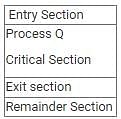Computer Science Engineering (CSE) Exam > Computer Science Engineering (CSE) Questions > Suppose P, Q and R are co-operating processes...
Start Learning for Free
Suppose P, Q and R are co-operating processes satisfying the Mutual Exclusion condition. Then if the process Q is executing in its critical section then:
- a)'P' does not executes in critical section.
- b)'P' executes in critical section.
- c)'R' does not executes in critical section.
- d)'R' executes in critical section.
Correct answer is option 'A,C'. Can you explain this answer?
| FREE This question is part of | Download PDF Attempt this Test |
Most Upvoted Answer
Suppose P, Q and R are co-operating processes satisfying the Mutual Ex...
A mutual exclusion condition (mutex) is a program object that prevents simultaneous access to a shared resource.
A critical section is a code segment that accesses shared variables and has to be executed as an atomic action. The critical section problem refers to the problem of how to ensure that at most one process is executing its critical section at a given time.
Process:

Since process 'Q' is in the critical section then other processes P and R cannot be in the critical section.
Therefore neither 'P' nor 'R' executes in their critical section.
Hence, the correct options are (A) and (C).
Free Test
FREE
| Start Free Test |
Community Answer
Suppose P, Q and R are co-operating processes satisfying the Mutual Ex...
Explanation:
When P, Q, and R are co-operating processes satisfying the Mutual Exclusion condition, it means that only one process can be in its critical section at a time. Let's analyze the given options:
a) P executes in critical section:
If Q is executing in its critical section, it implies that Q has acquired the lock or semaphore required for entering the critical section. In order for P to execute in its critical section, it would also need to acquire the same lock or semaphore. However, since mutual exclusion is enforced, only one process can acquire the lock at a time. Therefore, option 'a' is not possible.
b) P does not execute in critical section:
This option is incorrect because it contradicts the mutual exclusion condition. If P does not execute in its critical section, it would mean that multiple processes can be in their critical sections simultaneously, violating the mutual exclusion requirement.
c) R executes in critical section:
If Q is executing in its critical section, it implies that Q has acquired the lock or semaphore required for entering the critical section. If R is to execute in its critical section, it would also need to acquire the same lock or semaphore. Since mutual exclusion is enforced, R can only enter its critical section when Q releases the lock. Therefore, option 'c' is possible.
d) R does not execute in critical section:
This option is incorrect because it contradicts the mutual exclusion condition. If R does not execute in its critical section while Q is executing in its critical section, it would mean that multiple processes can be in their critical sections simultaneously, violating the mutual exclusion requirement.
Conclusion:
Based on the above analysis, the correct options are 'a' and 'c'. So, when Q is executing in its critical section, P can execute in its critical section and R can also execute in its critical section.
When P, Q, and R are co-operating processes satisfying the Mutual Exclusion condition, it means that only one process can be in its critical section at a time. Let's analyze the given options:
a) P executes in critical section:
If Q is executing in its critical section, it implies that Q has acquired the lock or semaphore required for entering the critical section. In order for P to execute in its critical section, it would also need to acquire the same lock or semaphore. However, since mutual exclusion is enforced, only one process can acquire the lock at a time. Therefore, option 'a' is not possible.
b) P does not execute in critical section:
This option is incorrect because it contradicts the mutual exclusion condition. If P does not execute in its critical section, it would mean that multiple processes can be in their critical sections simultaneously, violating the mutual exclusion requirement.
c) R executes in critical section:
If Q is executing in its critical section, it implies that Q has acquired the lock or semaphore required for entering the critical section. If R is to execute in its critical section, it would also need to acquire the same lock or semaphore. Since mutual exclusion is enforced, R can only enter its critical section when Q releases the lock. Therefore, option 'c' is possible.
d) R does not execute in critical section:
This option is incorrect because it contradicts the mutual exclusion condition. If R does not execute in its critical section while Q is executing in its critical section, it would mean that multiple processes can be in their critical sections simultaneously, violating the mutual exclusion requirement.
Conclusion:
Based on the above analysis, the correct options are 'a' and 'c'. So, when Q is executing in its critical section, P can execute in its critical section and R can also execute in its critical section.
Attention Computer Science Engineering (CSE) Students!
To make sure you are not studying endlessly, EduRev has designed Computer Science Engineering (CSE) study material, with Structured Courses, Videos, & Test Series. Plus get personalized analysis, doubt solving and improvement plans to achieve a great score in Computer Science Engineering (CSE).

|
Explore Courses for Computer Science Engineering (CSE) exam
|

|
Similar Computer Science Engineering (CSE) Doubts
Suppose P, Q and R are co-operating processes satisfying the Mutual Exclusion condition. Then if the process Q is executing in its critical section then:a)P does not executes in critical section.b)P executes in critical section.c)R does not executes in critical section.d)R executes in critical section.Correct answer is option 'A,C'. Can you explain this answer?
Question Description
Suppose P, Q and R are co-operating processes satisfying the Mutual Exclusion condition. Then if the process Q is executing in its critical section then:a)P does not executes in critical section.b)P executes in critical section.c)R does not executes in critical section.d)R executes in critical section.Correct answer is option 'A,C'. Can you explain this answer? for Computer Science Engineering (CSE) 2024 is part of Computer Science Engineering (CSE) preparation. The Question and answers have been prepared according to the Computer Science Engineering (CSE) exam syllabus. Information about Suppose P, Q and R are co-operating processes satisfying the Mutual Exclusion condition. Then if the process Q is executing in its critical section then:a)P does not executes in critical section.b)P executes in critical section.c)R does not executes in critical section.d)R executes in critical section.Correct answer is option 'A,C'. Can you explain this answer? covers all topics & solutions for Computer Science Engineering (CSE) 2024 Exam. Find important definitions, questions, meanings, examples, exercises and tests below for Suppose P, Q and R are co-operating processes satisfying the Mutual Exclusion condition. Then if the process Q is executing in its critical section then:a)P does not executes in critical section.b)P executes in critical section.c)R does not executes in critical section.d)R executes in critical section.Correct answer is option 'A,C'. Can you explain this answer?.
Suppose P, Q and R are co-operating processes satisfying the Mutual Exclusion condition. Then if the process Q is executing in its critical section then:a)P does not executes in critical section.b)P executes in critical section.c)R does not executes in critical section.d)R executes in critical section.Correct answer is option 'A,C'. Can you explain this answer? for Computer Science Engineering (CSE) 2024 is part of Computer Science Engineering (CSE) preparation. The Question and answers have been prepared according to the Computer Science Engineering (CSE) exam syllabus. Information about Suppose P, Q and R are co-operating processes satisfying the Mutual Exclusion condition. Then if the process Q is executing in its critical section then:a)P does not executes in critical section.b)P executes in critical section.c)R does not executes in critical section.d)R executes in critical section.Correct answer is option 'A,C'. Can you explain this answer? covers all topics & solutions for Computer Science Engineering (CSE) 2024 Exam. Find important definitions, questions, meanings, examples, exercises and tests below for Suppose P, Q and R are co-operating processes satisfying the Mutual Exclusion condition. Then if the process Q is executing in its critical section then:a)P does not executes in critical section.b)P executes in critical section.c)R does not executes in critical section.d)R executes in critical section.Correct answer is option 'A,C'. Can you explain this answer?.
Solutions for Suppose P, Q and R are co-operating processes satisfying the Mutual Exclusion condition. Then if the process Q is executing in its critical section then:a)P does not executes in critical section.b)P executes in critical section.c)R does not executes in critical section.d)R executes in critical section.Correct answer is option 'A,C'. Can you explain this answer? in English & in Hindi are available as part of our courses for Computer Science Engineering (CSE).
Download more important topics, notes, lectures and mock test series for Computer Science Engineering (CSE) Exam by signing up for free.
Here you can find the meaning of Suppose P, Q and R are co-operating processes satisfying the Mutual Exclusion condition. Then if the process Q is executing in its critical section then:a)P does not executes in critical section.b)P executes in critical section.c)R does not executes in critical section.d)R executes in critical section.Correct answer is option 'A,C'. Can you explain this answer? defined & explained in the simplest way possible. Besides giving the explanation of
Suppose P, Q and R are co-operating processes satisfying the Mutual Exclusion condition. Then if the process Q is executing in its critical section then:a)P does not executes in critical section.b)P executes in critical section.c)R does not executes in critical section.d)R executes in critical section.Correct answer is option 'A,C'. Can you explain this answer?, a detailed solution for Suppose P, Q and R are co-operating processes satisfying the Mutual Exclusion condition. Then if the process Q is executing in its critical section then:a)P does not executes in critical section.b)P executes in critical section.c)R does not executes in critical section.d)R executes in critical section.Correct answer is option 'A,C'. Can you explain this answer? has been provided alongside types of Suppose P, Q and R are co-operating processes satisfying the Mutual Exclusion condition. Then if the process Q is executing in its critical section then:a)P does not executes in critical section.b)P executes in critical section.c)R does not executes in critical section.d)R executes in critical section.Correct answer is option 'A,C'. Can you explain this answer? theory, EduRev gives you an
ample number of questions to practice Suppose P, Q and R are co-operating processes satisfying the Mutual Exclusion condition. Then if the process Q is executing in its critical section then:a)P does not executes in critical section.b)P executes in critical section.c)R does not executes in critical section.d)R executes in critical section.Correct answer is option 'A,C'. Can you explain this answer? tests, examples and also practice Computer Science Engineering (CSE) tests.

|
Explore Courses for Computer Science Engineering (CSE) exam
|

|
Suggested Free Tests
Signup for Free!
Signup to see your scores go up within 7 days! Learn & Practice with 1000+ FREE Notes, Videos & Tests.
























